
Making life better for bats and people in Canada
Bats are mysterious yet familiar creatures. While they're often misunderstood, one thing is clear. Millions more bats could perish in the coming years from a fungus that causes white-nose syndrome. Parks Canada works alongside many groups to monitor bats. By better understanding bats and their habitat, we can help their recovery.
Protecting bats and their habitats
There are more than 1,400 species of bats in the world. Canada has 18 species of bats. Of those, 13 bat species are known to occur across 37 national parks and 5 national historic sites. Helping bats is an important part of Parks Canada’s conservation work. We work with partners across the country to protect bats and their habitats.
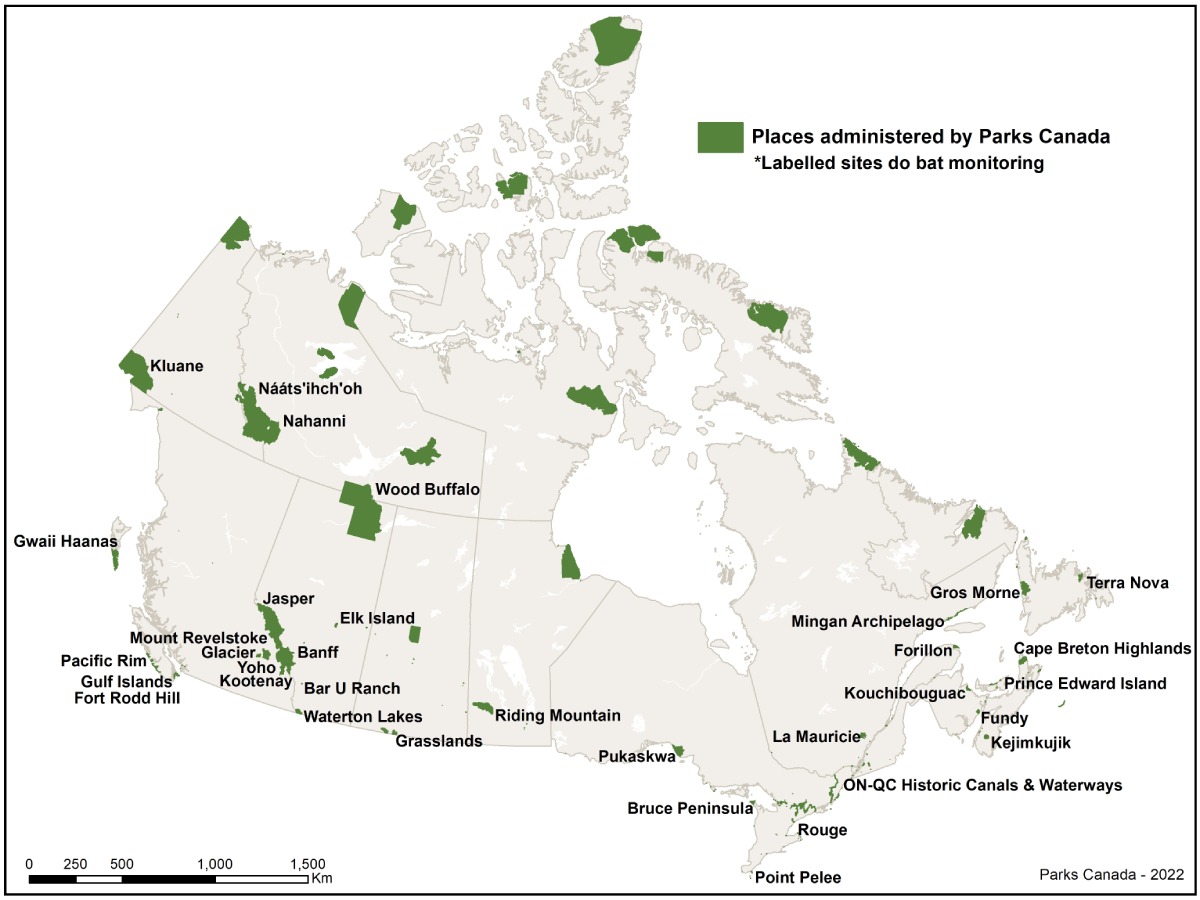
View larger image
A map of places administered by Parks Canada that do bat monitoring work
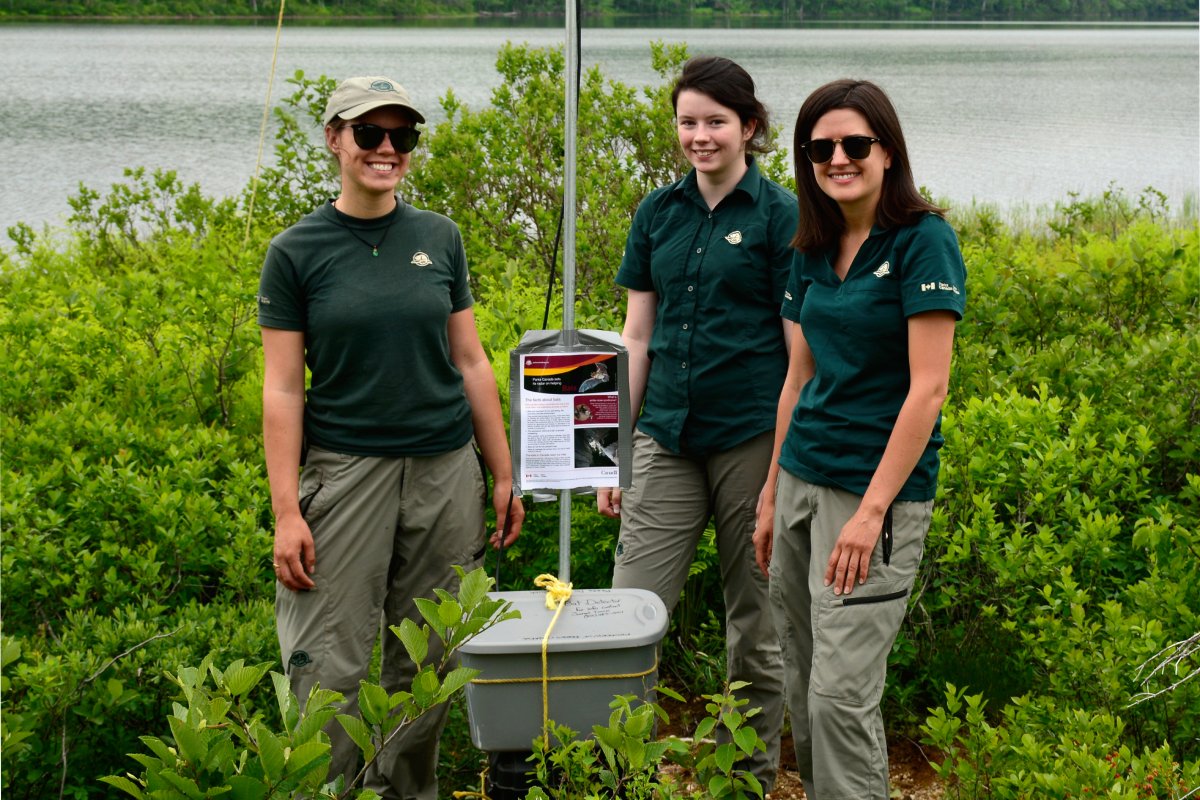
Parks Canada takes many actions to better understand, conserve and protect bats. For instance, we:
- implement bat monitoring protocols
- use a variety of survey techniques to identify bat species and their habitat
- track the spread of white-nose syndrome (WNS)
- create and use best management practices for bats in buildings and other structures
- promote the conservation of bat habitat. And when important habitat is lost, replace it with alternative habitat like bat boxes
- develop outreach programs for homeowners and the public to educate others on bats and inspire enthusiasm for bat conservation
Click to enlarge images
Staff in La Mauricie National Park help protect and restore bat populations and their habitats. The team is working with other Parks Canada administered sites in Quebec to protect three bat species at risk.
Watch this video to learn how they are using acoustic monitoring to study bats!
Bats: an Ally Worth Protecting
Text transcript
[Parks Canada beaver logo][Parks Canada scientists walk through forest and tall grass in Forillon National Park wearing their dark green Parks Canada uniforms.] [Antoine speaks directly into the camera while, in the background, his colleague observes a building through binoculars.] My name is Antoine Plouffe Leboeuf.
[Name Tag] Antoine Plouffe Leboeuf, Ecosystem Scientist, Forillon National Park.
I’m an ecosystem scientist at Forillon National Park and I’m going to talk to you about our bat conservation work.
[Title] Field Notes: Bats, an Ally Worth Protecting.
[Antoine stands amid tall grass and speaks to the camera while two other Parks Canada staff members set up research equipment behind him.]
Today, we’re in the field to install ultrasound recorders, in order to measure bat activity in Forillon National Park.
[Parks Canada scientists, Steve and Michaël, stand amongst tall grass while setting up their sound recording equipment.]
[A timelapse depicts Parks Canada employees installing sound recording equipment in a forest near a stream. The pole is inserted into the ground so the pole stands vertically, with a square sound recording device attached to it.]
So, bats emit sounds that are inaudible to the human ear,
but we can measure them with specialized devices.
[Steve crouches on the ground to get a better look at the screen of the sound recording device.]
To be able to measure the activity rate in our park,
we placed our devices near feeding sites.
[The camera flies over a nearby stream in the forest.]
Bats feed mostly on insects and so it's good to place the stations
near streams, marshes and ponds......places where there are a lot of insects.
[With the sound recording device set up, the Parks Canada employees hike out of the research site.]
[Text] In Canada, bats play an essential role in maintaining ecological balance by controlling insect populations.
[Text] Parks Canada is part of a dynamic community of bat researchers across Canada.
[Text] We work with private landowners, universities and other conservation organizations to better understand and protect bats.
To protect species like bats,
it takes a group effort, so at Parks Canada we started a great collaboration
[Two Parks Canada scientists stand at the end of a dock in La Mauricie National Park.]
[Location Tag] La Mauricie National Park
with La Mauricie National Park,
[Two Parks Canada scientists are installing sound recording equipment near the coast in Mingan Archipelago National Park Reserve]
[Location Tag] Mingan Archipelago National Park Reserve
Mingan Archipelago National Park Reserve
[Three Parks Canada scientists stand next to a sound recording device in a forest in Forillon National Park.]
[Location Tag] Forillon National Park
and with us, Forillon National Park, to work on bat conservation and more specifically
[A photo of a Little Brown Bat hanging in a cave.]
[Text] Little Brown Bat
on three bats at risk: the Little Brown Bat,
[A photo of a Northern Bat on a researcher’s gloved hand]
[Text] Northern Bat
the Northern Bat and the Eastern Pipistrelle.
A photo of an Eastern Pipistrelle bat hanging from the ceiling in a cave.
[Text] Eastern Pipistrelle
The photo zooms into the face of the Eastern Pipistrelle, revealing a white fungus on the bat.
[Text] In Canada, the main threats to bats are habitat loss and a fungal disease called white-nose syndrome
[Label] Fungus (Evidence of white-nose syndrome)
[Text] Our goal is to help restore bat populations by protecting hibernation sites, maternities and shelters.
We are also tracking the progression of white-nose syndrome.
[Label ] Bat shelter
[Antoine speaks into the camera while, behind him, his colleague uses binoculars to observe a building that has a bat roost in the attic.]
[Location Tag] Forillon National Park
We’ve conducted twilight inventories by observing our buildings
to check for the presence of bats.
[An old white building that the scientists are observing for bat activity sits on the ocean shore while the sun sets in the distance.]
We do that just before sunset because now is the time that bats usually choose to go out hunting at night.
[Two Parks Canada scientists, Josée and Valérie, observe a heated bat nest box for signs of bats.]
[Label] Heated nest box
[Name Tag] Josée Blier, Resource Management Officer, La Mauricie National Park
[Name Tag] Valérie Turcotte-Blais, Resource Management Technician, La Mauricie National Park
[Location Tag] La Mauricie National Park
So we have binoculars, then we observe the potential exits to possibly find our famous bats.
[Text] Like in Forillon, other Parks Canada sites in Quebec regularly look for, listen to and monitor bats.
[Josée approaches a log cabin and puts her ear up to the outside wall, listening for bat movement inside.]
[Location Tag] Mingan Archipelago National Park Reserve
[Parks Canada scientists at Mingan Archipelago National Park Reserve install a sound recording device near the shore.]
This evening, we’re doing mobile inventories of bats.
[Parks Canada scientists in La Mauricie National Park prepare a vehicle to do acoustic surveys by mounting a microphone onto a pole and attaching it to the outside of the vehicle.]
[Location Tag] La Mauricie National Park
To do this, we attach a microphone to a pole that we will have outside the vehicle, then we will drive on a road which crosses the park.
[Antoine speaks into the camera while, behind him, a Parks Canada staff member attaches a microphone on a long pole to a Parks Canada truck.]
[Location Tag] Forillon National Park
[A Parks Canada truck drives by in the dark with its headlights on and the microphone attached to the vehicle’s hood.]
It will allow us to document all the bats encountered that will be detected by our recorder.
[A Parks Canada scientist sits in the front seat of the vehicle in the dark with a laptop open, recording the ultrasonic bat noises that the microphone is picking up.]
Then this inventory gives us an idea of the relative abundance of bats found in the park.
[Antoine and another Parks Canada staff member hike through tall grass into a forest to retrieve the recording device that they installed days earlier.]
So today we came to take down the station, the fixed recorder.
It's been ten nights that the device has been taking recordings of bats and we think we’re going to have lots of recordings because the temperature was good.
[Name Tag] Marie-Soleil Pétrin, Resource Conservation Officer, Mingan Archipelago National Park Reserve
[Name Tag] Adam Desjardins, Resource Conservation Officer, Mingan Archipelago National Park Reserve
[Location Tag] Mingan Archipelago National Park Reserve
[Parks Canada scientists, Marie-Soleil and Adam, hike in to retrieve the sound recorder that has been placed at Mingan Archipelago National Park Reserve.]
It's been hot, there's been no rain and then the winds were still relatively weak.
So the conditions have been ideal for having bats on our site.
[Scientists at both Mingan Archipelago National Park Reserve and Forillon National Park remove the SD memory cards from the recording devices so the recordings can be analyzed.]
And so today, we take down the station and we can go look at our recording data which will be on an SD card.
We will be able to analyze it using special software afterward.
[A Parks Canada scientist from La Mauricie National Park analyzes a bat sound recording on her computer. A graphic appears in the top left corner that shows the sound waves of the bat echolocation.]
[Label] A sound clip of a bat using echolocation to find food. The clip has been slowed down to be audible to the human ear.
[Antoine speaks directly into the camera, while kneeling in the forest where the sound recording device was placed.]
So by working together and also by working with other conservation organizations of North America,
we increase our chances of success to protect this species.
[A Parks Canada employee sits inside a vehicle at La Mauricie National Park, analyzing bat recordings on their computer.]
[Parks Canada scientists in Mingan Archipelago National Park Reserve return to their boat, anchored on the coast, so they can head back to the mainland after retrieving the bat recording data.]
[A drone flies over Parks Canada staff who are working at a bat monitoring site in a remote location in Mingan Archipelago National Park Reserve.]
[Text] Learn more about bat conservation at Parks Canada: parkscanada.gc.ca/canada-bats
[End screen directing viewers to related videos.]
Parks Canada logo
Canada wordmark
Jump ahead to learn more about the many ways that Parks Canada works to protect bats.
Nocturnal flying mammals
Bats are nocturnal and are the only mammals that can fly. They can “see with their ears” during flight by emitting ultrasonic bat calls called echolocation. People can’t hear bat calls without using special acoustic recording devices. This makes studying bats tricky, but interesting!
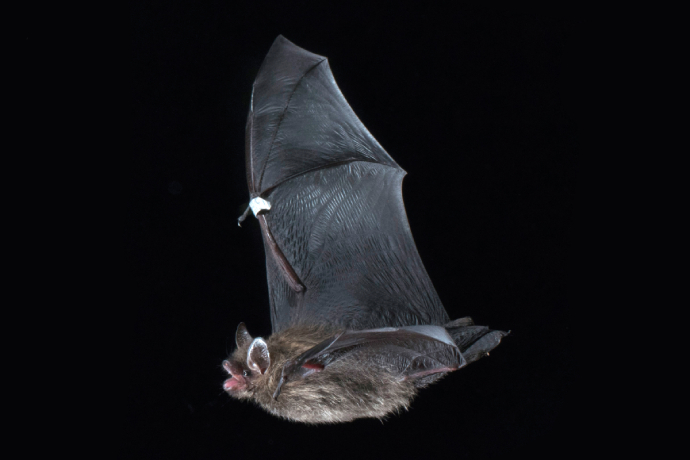
.jpg)
Once you start working on bats, you become very attached. They're very charismatic animals. They’re actually more akin to grizzly bears than mice. They live a long time and only have one pup [baby bat] per year.
Bats have unique habitat needs for different parts of the day, season, and year. For instance,
- in the summer, bats roost in mature forests, buildings, and near waterbodies
- many hibernating bat colonies overwinter in cool and humid areas, like caves
- mother bats need maternity roosts with particular temperature and humidity levels to birth and raise pups
These needs vary between species.
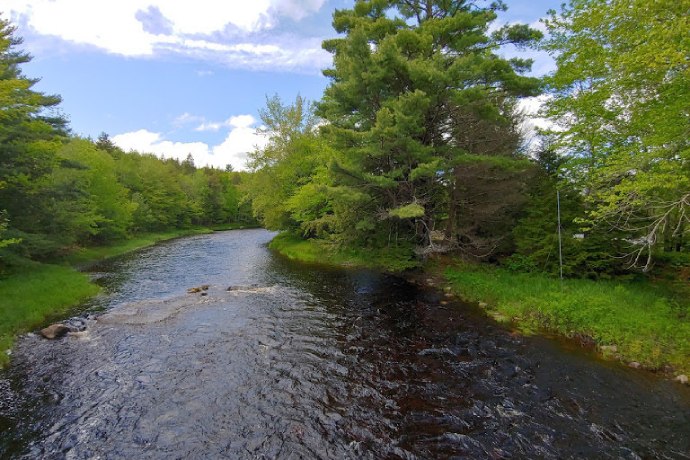

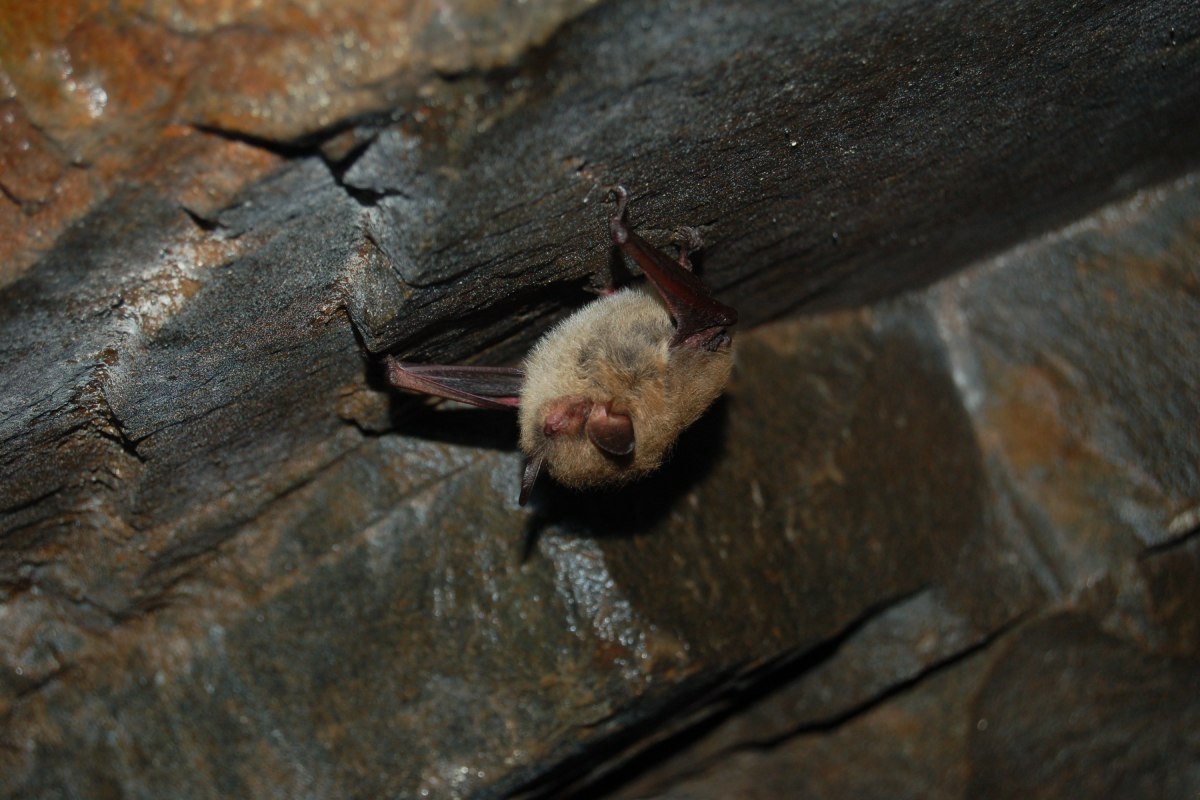
Why we need bats
Bats play an important role in the ecosystem as an effective pest control. The Little Brown Bat, or Little Brown Myotis (Myotis lucifugus) can devour 600 insects in an hour, including mosquitos, moths, and beetles. Their services controlling insect pests is valued at more than 3.7 billion dollars in the U.S. each year.
The Little Brown Bat used to be the most abundant bat species in the region. Since white-nose symdrome, it's now one of the most rare. So the effects on the ecosystem at the food chain level are not well known.
Bats reduce the need for chemical pesticides to treat crops. This costs farmers less money, reduces environmental pollution, and helps with food security. In tropical countries, bats are even known to pollinate important crops like mangoes, bananas, and blue agave (from which tequila is made)!
.jpg)
Deadly outbreak of a wildlife disease
Hibernating bats, like the Little Brown Bat, were once a familiar sight in the skies at dusk in Eastern Canada. Yet millions of hibernating bats in North America have died from a fungus that causes white-nose syndrome. Many experts are calling WNS the worst wildlife disease outbreak in modern times.
White-nose syndrome is named for the white fuzz that grows on the nose, ears, and wings of infected bats. Infected bats wake early and repeatedly from hibernation, causing them to use precious winter fat stores. Unable to hunt for insects in the cold winter, bats often starve to death.
The disease thrives in cool and damp environments. It is spreading across many places where bats hibernate, like caves. WNS transfers easily between bats when they’re cuddled up together during hibernation.
An outbreak of WNS can kill 99% of bats in one colony.
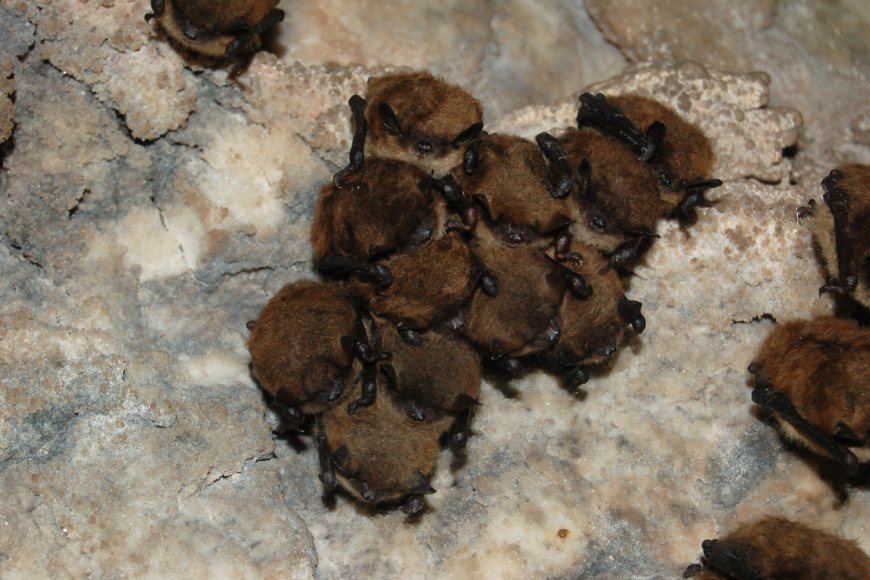
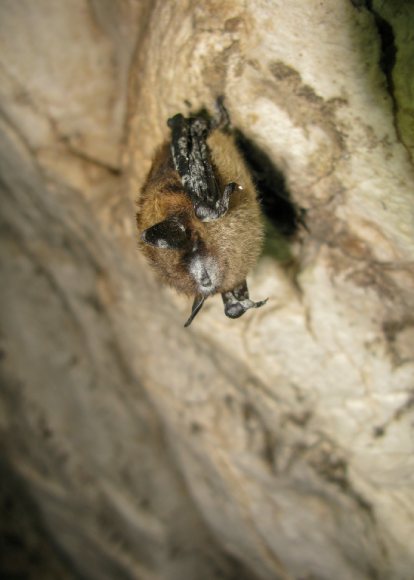
By 2009, white-nose syndrome plummeted the populations of three different bat species. In 2014, three bat species were listed as Endangered by COSEWIC. These bats are the:
- Little Brown Brown Bat
- Northern Long-eared Bat
- Tri-colored Bat (weighing about a toonie)
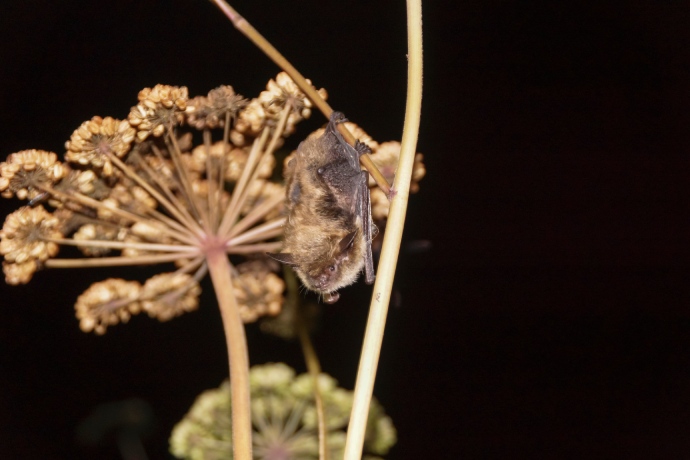
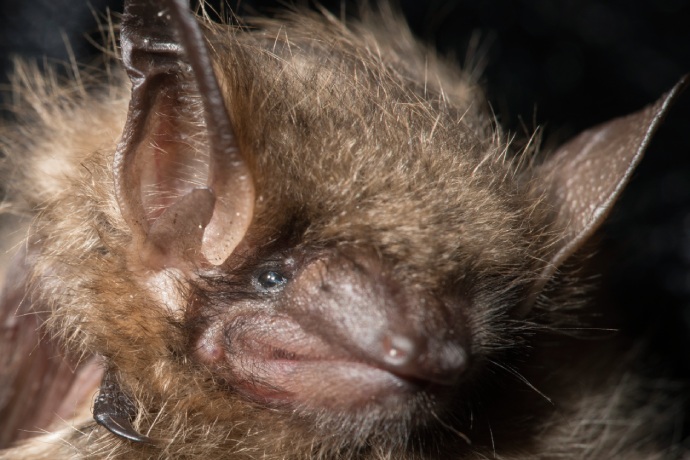
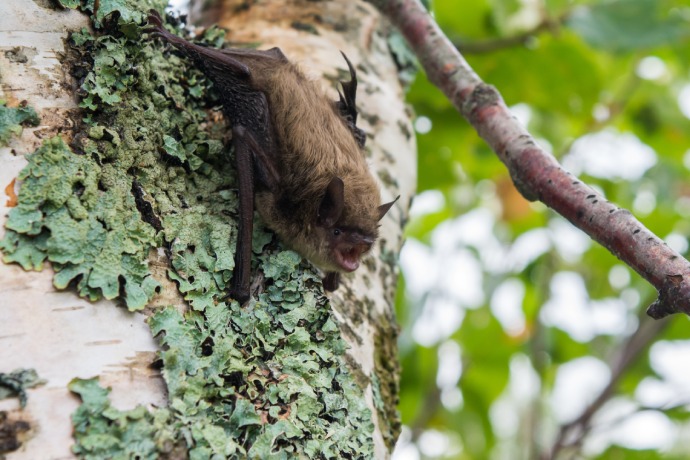
Since then, WNS has been spreading across Eastern Canada, and is heading West. If the disease continues to spread at its current rate, all of Canada’s hibernating bats could be infected within 12-18 years. Experts believe that without implementing recovery actions, Canada could lose all of its cave-dwelling bats.
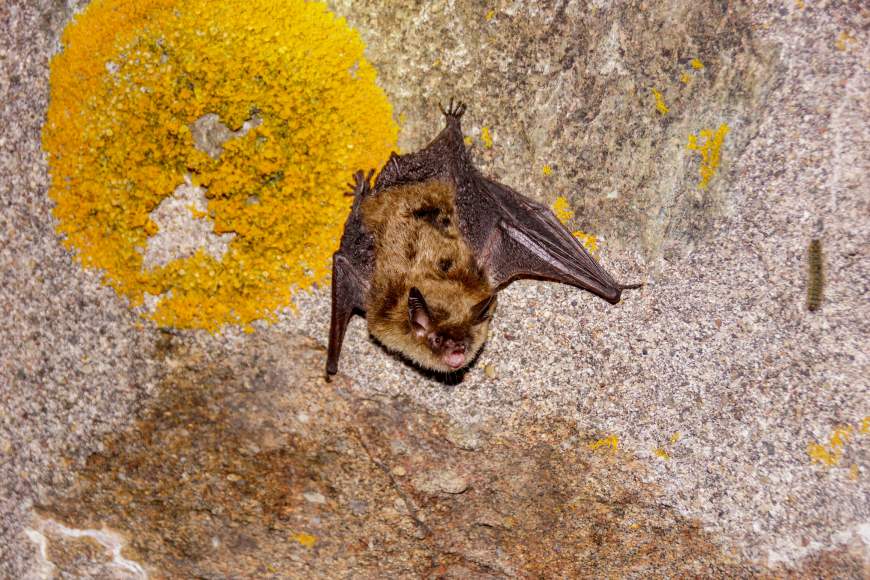
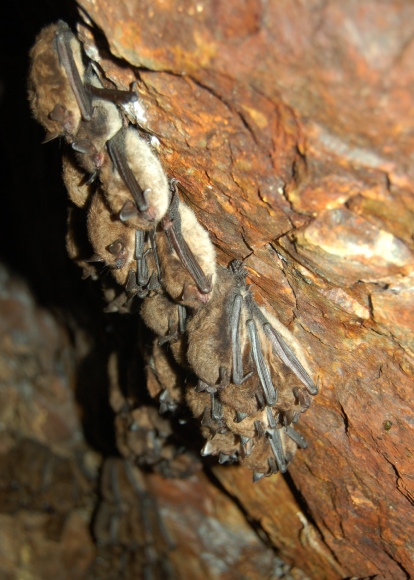
Actions on the ground—and in the air
Parks Canada researches and monitors bats and improve their chance of recovery. An added benefit of protecting bats is preserving the valuable services they provide. We collaborate with many groups to better understand bats, including:
- other federal departments and agencies
- provincial governments
- Indigenous groups
- non-governmental organizations
- academic researchers
- volunteers and citizen scientists
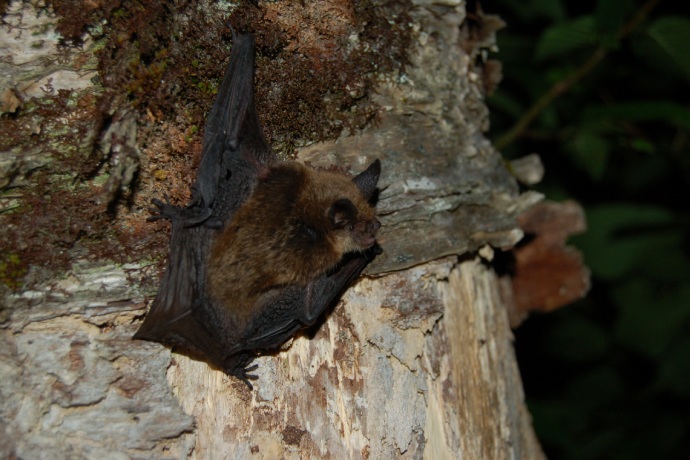
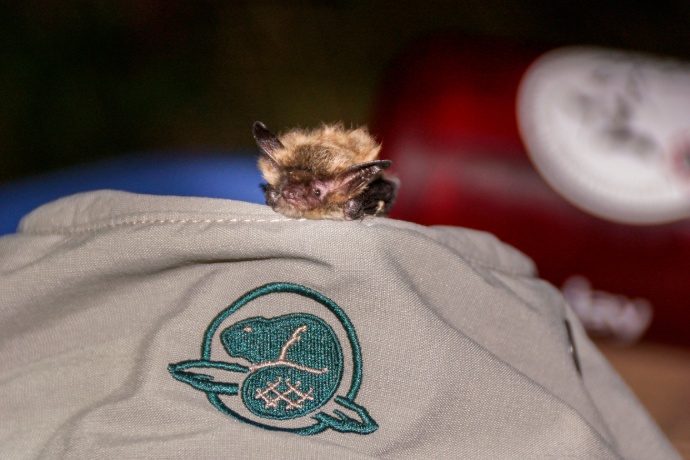
Parks Canada conservation experts across the country are actively implementing recovery strategies for bats. Some of these conservation actions include:
Monitor and survey bats
Parks Canada works in close collaboration with the North American Bat Monitoring Program (NABat). This multi-agency initiative spans Canada, the United States, and Mexico. Parks Canada follows NABat protocols to collect bat data on:
- acoustic recording surveys for monitoring
- maternity colony counts to learn about mother bats and their young
- hibernaculum counts to learn about their winter hibernation sites
- mist-netting and tagging bats to safely check gender and health and to track bats
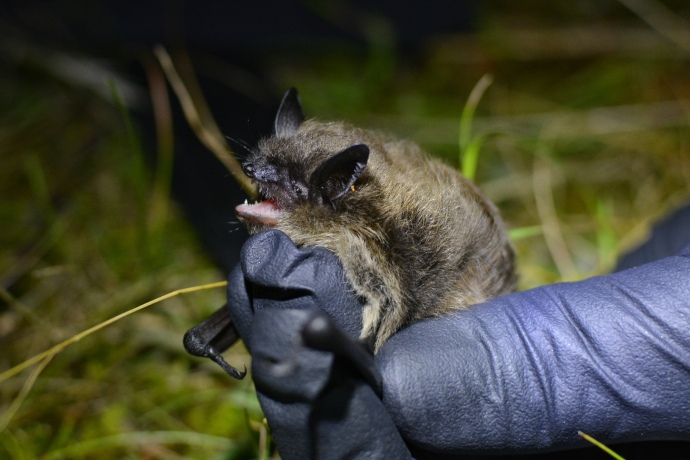
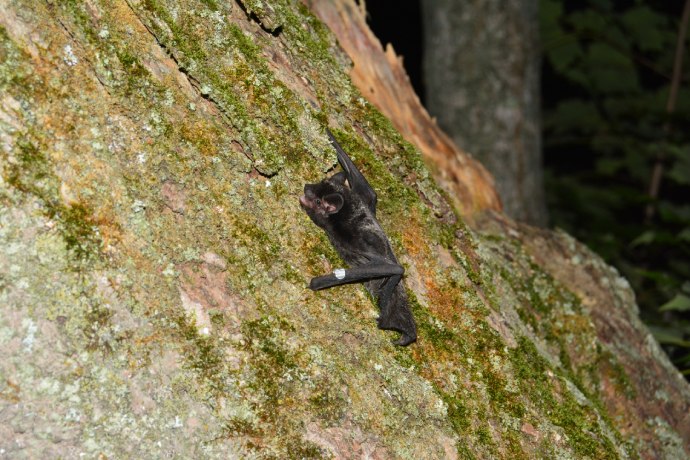
The data that Parks Canada collects, where possible, is included in NABat. These data help managers create conservation actions that support bat health and survival. Two NABat hubs provide opportunities for regional collaboration. Parks Canada participates in the Atlantic NABat hub and the new NABat hub in Alberta. More NABat hubs are being formed in Canada as well.
We formed the Alberta Bat Working Group to improve bat conservation across a larger landscape and to consistently monitor bats. Its members include all of the Alberta national parks (Parks Canada), Alberta Environment and Parks, Alberta Biodiversity Monitoring Institute, and the University of Alberta. I’m constantly impressed by the work that the bat community puts in. They’re really passionate and wonderful people.
Acoustic monitoring
Most bats use echolocation to navigate, hunt, socialize, and more. Their calls bounce off objects, like an echo, when they navigate and hunt at night. This gives bats details about their world that they use to avoid obstacles and catch prey.
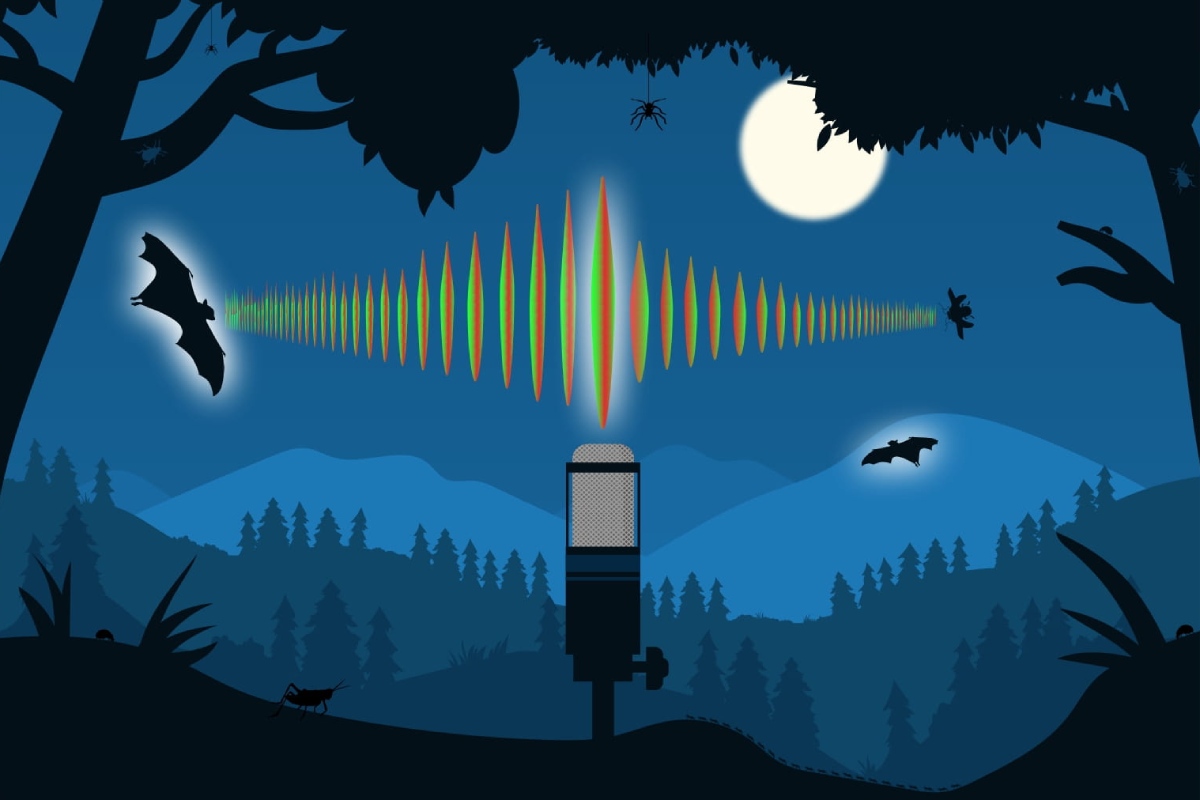
Given that many bats have calls that can’t be heard by humans, Parks Canada uses ultrasonic recording equipment to detect and monitor bats. We then use special software that translates the bat recordings into a visual of the sound, called a sonogram. Sonograms let us look at and listen to sounds emitted by bats. This allows us to better understand and protect bats.
Click to enlarge images
It’s a bit like listening to bird calls…in that you have a general idea of ‘who’ is speaking, like a Chickadee or a Blue Jay. Monitoring year after year gives a broad stroke picture of whether bat activity is changing over time.
Conservation staff use sonograms to help identify bat species. All Canadian bat species echolocate, and each species has a different call signature. For example, some appear curved like hockey sticks, while others are V-shaped like mountain valleys. These recordings can also tell us how bats are using the land. For instance, a flurry of sounds can indicate that a hibernation site, feeding site, or maternity roost is nearby. Only trained wildlife experts can handle bats, and it is a challenge to observe bats at night. Acoustic recording provides a less invasive way to listen to bats.
Watch the call of a Tri-colored Bat recorded at Kejimkujik National Park and National Historic Site
Text transcript
A series of continuous calls emitted by a Tri-colored Bat. The bat will switch between higher and lower frequency calls to give it details about closer objects. The calls or echolocations get more frequent as it approaches an object. [The gaps between calls have been condensed for this recording]. By Lori Phinney, Mersey Tobeatic Research Institute
Listen to the call of a Myotis Bat species recorded in Cape Breton Highlands National Park
.jpg)
Text transcript
A bat emits many ultrasonic pulses of sound over several milliseconds as it navigates through the air. This audio clip has been lowered in pitch and slowed down so we can hear it. The pulses get more and more frequent as the bat zones in on a prey item. The clip ends with a “feeding buzz”, or a dense cluster of sounds as the bat attempts to capture its prey.Listen to the call of a Silver-haired Bat recorded in Cape Breton Highlands National Park

Text transcript
A series of slower pulses echoes into the distance as the bat searches for food. This sound clip has been lowered in pitch and slowed down to enable us to hear it.These sonograms have been condensed in time for identification purposes. They are not an accurate representation of the call signatures in real-time.
Research
Research partnerships allow Parks Canada to collaborate on “bigger picture” bat conservation issues. The data gained from monitoring bats with partners helps inform conservation actions locally. Parks Canada uses acoustic monitoring and other survey techniques to better understand the:
- bat species at each site to create a local inventory of bats
- number of bats and health status
- habitats and environmental conditions preferred by bats
- behaviours that indicate that a winter hibernation site (hibernacula) is near
- before and after arrival of WNS surveys to see if the number of bats and their change in distribution over time


Housing bats
By monitoring bats, Parks Canada can identify areas that are important to bats, like roosting and hibernation sites. Once we know where bats are, we can take actions to help protect those habitats.
Staff at Prince Edward Island National Park took drastic action with researchers and landowners to preserve a known maternity roosting site on a property outside of the park. While staff at Rouge National Urban Park built bat condos to provide new roosting sites for bats.
Parks Canada has created in-house guidelines for checking buildings and structures for bat habitat.
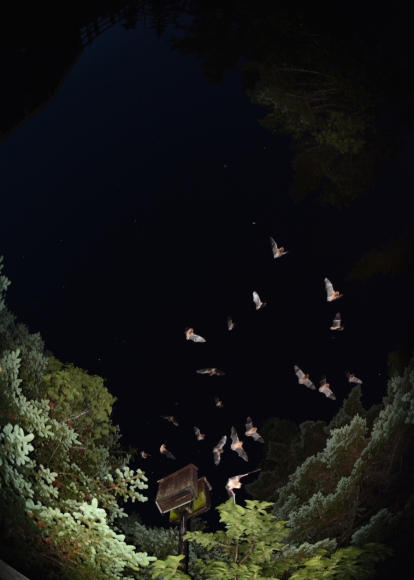
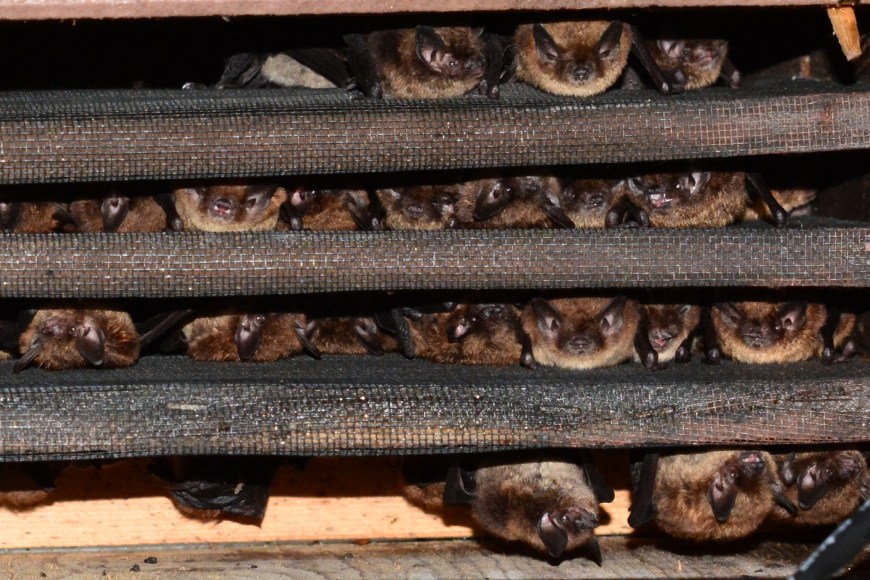
A welcomed neighbour
Bats need habitats to rest and raise their young. Yet habitat loss from urban development, deforestation, and exclusions from structures are increasing the loss of bats.
But bats don’t have to be an unwelcome pest in your structures... Both people and bats can co-exist together! A well designed bat box could mitigate habitat loss.
However, it’s not really known which bat box designs are most beneficial to bat species in Canada. Parks Canada participates in the national BatBox project led by Dr. Karen VanDerwolf from Trent University.
This project helps us understand which bat box designs are most attractive to which bat species, at what times, and in what locations. The outcomes of this project will help guide design considerations for bat boxes that meet the needs of local bats.
Whether watching bats use your newly built bat box, or having less insects around your yard—bats can make for welcomed neighbours.

There’s still hope
Despite big losses to bat populations, not all bats have disappeared. All three endangered bats are still being detected across Parks Canada, along with many other bat species.
We’re trying to preserve and protect bats that are still here. It is a devastating disease… but we haven't seen our bat populations that are affected by it disappear. They’re still here in very low numbers.
White-nose syndrome has not yet reached some western provinces. It’s not too late to collect important baseline data in those areas to better understand bat populations before it hits.
Despite being Canada’s first national park, we didn’t have a lot of information on bats in Banff. We have started to collect data on bats knowing that white-nose syndrome is coming. We established a baseline of what bats are here, about how many, and where they are. Now we can look at changes over time.
Through research, monitoring, and conservation, we can protect the places that are most important to bats. We can give bats the space they need to survive.
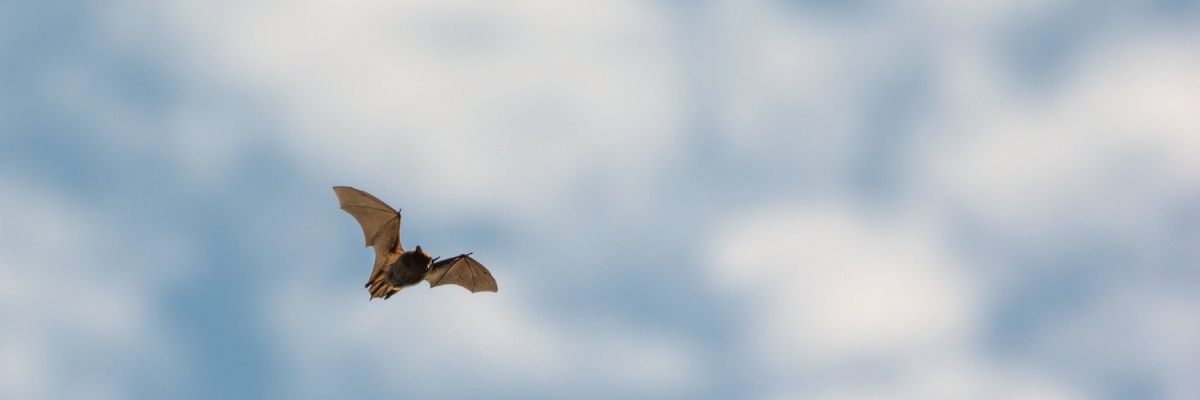
Your help matters to bats
There are lots of ways that you can help protect bats! You can:
- report your bat sightings!
- observe bats
- note your observation (date/time, location, general description, i.e., size and colour, and take a photo if able to do safely)
- report it to the Canadian Wildlife Health Cooperative using their national online reporting tool for all wildlife (healthy or otherwise)
- contribute to bat box research by participating in the BatBox project
- reduce your use of pesticides—bats are a natural form of pest control
- learn about bats and attend a bat event
- avoid entry into caves, abandoned buildings, and other places where bats may hibernate to help slow the spread of WNS
- create bat habitat by planting different species of trees. Leave old dead softwood trees on your property, especially those with hollow cavities

Remember! It is illegal to remove or dislodge a bat colony. Reach out to your local wildlife authority for advice on excluding bats from your home, or helping bats find new homes.
- Date modified :
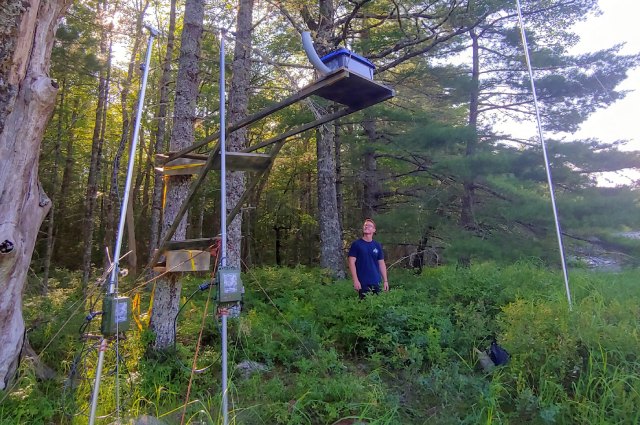
.jpg)
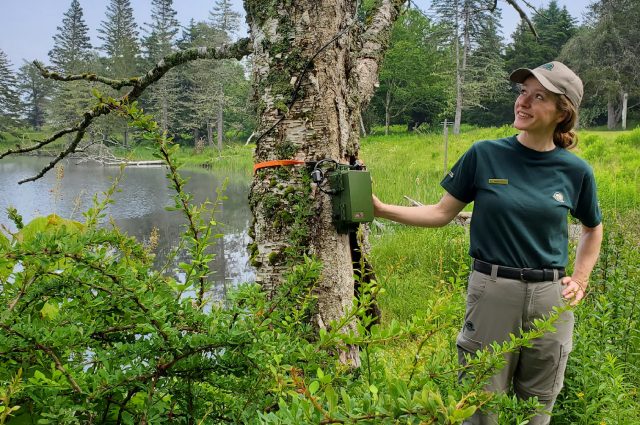



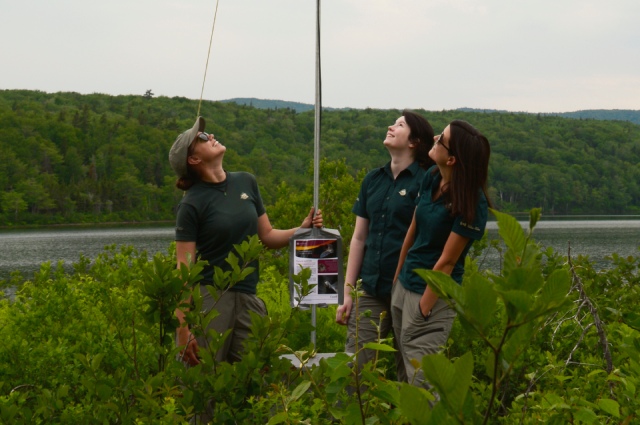
.jpg)